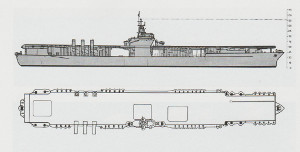![]() The Pacific War Online Encyclopedia
The Pacific War Online Encyclopedia
|
| Previous: Ramsey, Dewitt C. | Table of Contents | Next: Rangers |
 ONI 222 |
| Tonnage | 13,800 tons standard displacement |
| Dimensions | 769'0" by 80'0" by 51'0"" 234.39m by 24.38m by 15.54m |
| Maximum speed | 29.25 knots |
| Complement | 1369 |
| Aircraft | 709' by 86' (216.10m by 26.21m) flight deck 2 elevators 55 aircraft |
| Armament | 8 5"/25
dual-purpose guns 6x4 1.1"/75 AA guns 12 0.50 machine guns |
| Protection | 48 tons: 2" (51mm) sides and bulkheads/1" (25mm) top steering gear |
| Machinery |
2-shaft Parsons geared
turbines (53,500 shp) 6 Babcock & Wilson boilers |
| Bunkerage | 2350 tons fuel oil 135.840 gallons (514,210 liters) aviation gasoline |
| Range | 10,000 nautical milesl (16,000 km) at 15 knots |
| Munitions capacity | 839 tons |
| Sensors | CXAM1 air
search radar |
The Ranger was completed in 1934. It was the
first purpose-built aircraft carrier in the United States fleet and
sacrificed almost all other qualities in favor of carrying the
maximum possible number of aircraft on the minimum possible
displacement. The result was a badly unbalanced design.
Unlike the previous Lexingtons, the
Ranger was constructed
with a flight deck that was built as a light superstructure rather
than as an integral part of the hull. The original design called
for a flush flight deck, which resulted in several unfavorable
design tradeoffs, only to have a deck island adopted almost at the
last minute. Exhaust was vented through six folding stacks that
proved problematic enough to never be repeated in any American
carrier design. The Ranger was almost completely lacking
in any form of protection, other than locating the magazines as
low as possible in the ship and placing minimal armor protection
around the steering gear.
The authorized air group on 7 December 1941 was one
fighter squadron of 18
fighters and one scout and one bombing squadron of 18 dive bombers
each. Together with the air group commander's dive bomber, this
totaled 55 aircraft. There was no torpedo magazine or other
provisions for torpedo bombers.

|
 |
References
The Pacific War Online Encyclopedia © 2016 by Kent G. Budge. Index